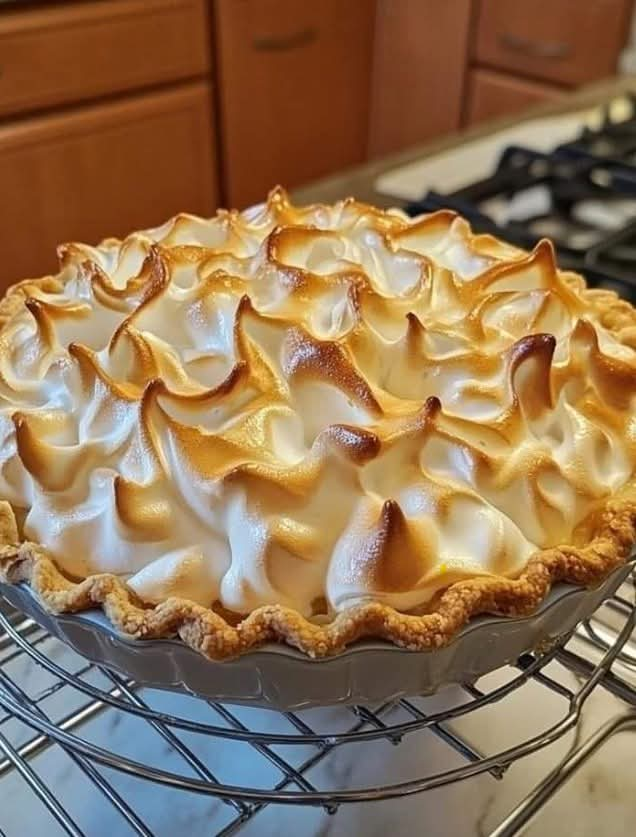Lemon Meringue Pie
Introduction
Lemon meringue pie is a timeless dessert that blends the tangy brightness of lemon custard with the delicate sweetness of fluffy meringue.
This dessert is perfect for those who enjoy a harmonious balance of flavors and textures, as it combines a buttery crust, creamy filling, and light, airy topping.
Whether served as a centerpiece at a holiday gathering or as a simple weekend treat, this pie never fails to impress.
The history of lemon meringue pie dates back to the 19th century, when bakers began combining citrus fruits with egg whites to create this beloved dessert.
Ingredients
/1 pre-baked 9-inch pie crust
/1 1/4 cups granulated sugar
/1/4 cup cornstarch
/1/4 teaspoon salt
/1 1/2 cups water
/3 large egg yolks
/1/3 cup freshly squeezed lemon juice
/1 tablespoon lemon zest
/2 tablespoons unsalted butter
/4 large egg whites
/1/4 teaspoon cream of tartar
/1/2 cup granulated sugar (for meringue)
Instructions
Prepare the pie crust first, ensuring it is fully baked and cooled before adding the filling. This creates a sturdy base for the lemon custard and prevents sogginess.
Choose a store-bought crust for convenience or make a homemade one for a richer flavor.
In a medium saucepan, whisk together sugar, cornstarch, salt, and water. Cook over medium heat.
stirring constantly, until the mixture thickens and becomes clear. This forms the base of your custard.
Remove the pan from heat and slowly whisk in the egg yolks, lemon juice, and lemon zest.
Return to low heat and cook until the custard is thick and creamy. Be careful not to overcook, as this can cause curdling.
Add butter to the custard and mix until fully incorporated. The butter adds a silky texture and enhances the lemon flavor.
Allow the mixture to cool slightly before pouring it into the prepared pie crust.
To make the meringue, beat egg whites and cream of tartar on medium speed until soft peaks form.
Gradually add sugar and continue beating until stiff, glossy peaks develop. This ensures the meringue holds its shape when baked.
Spread the meringue over the lemon filling, ensuring it touches the edges of the crust. This seals the filling and prevents shrinking. Use a spatula to create decorative peaks or swirls.
Bake the pie in a preheated oven at 350°F until the meringue is golden brown. Allow it to cool completely before slicing to ensure clean, neat cuts.
How to Make
Start by gathering all ingredients and ensuring the pie crust is ready. Preparing the custard requires.
precise measurements and attention,so having everything at hand will make the process smooth and efficient.
When making the custard, patience is key. Stirring constantly prevents lumps and ensures the mixture thickens evenly.
The balance of sugar and lemon juice is crucial for achieving the ideal level of sweetness and tanginess.
Incorporating the egg yolks gradually is important to prevent them from cooking too quickly. Tempering the yolks helps blend them seamlessly into the custard for a creamy texture.
The meringue is an essential component that adds lightness to the pie. Beating the egg whites correctly ensures.
they form stable peaks. Adding the sugar gradually allows it to dissolve fully, creating a smooth, glossy finish.
Spreading the meringue evenly over the filling is vital for even baking. Sealing it to the crust prevents air pockets and ensures the meringue doesn’t separate from the custard during baking.
While baking the pie, keep an eye on the meringue to avoid over-browning. A golden color signals that it’s perfectly baked. Letting the pie cool fully is crucial for setting the layers properly.
Serving the pie chilled or at room temperature enhances its flavor and texture. Each slice showcases .
the beautiful layers of crust, lemon custard, and meringue, making it as visually appealing as it is delicious.
Tips
Use freshly squeezed lemon juice for the best flavor. Bottled lemon juice can lack the bright, tangy taste that makes this pie special.
Adding lemon zest to the custard intensifies the citrus flavor and adds a delightful aroma. A microplane grater works best for achieving fine zest without bitterness.
Chilling the pie before serving helps the custard set firmly, making it easier to slice and serve. A few hours in the refrigerator works wonders.
Avoid making the meringue on a humid day, as excess moisture can prevent it from forming stiff peaks. A cool, dry kitchen is ideal for this step.
Using a metal or glass bowl for beating egg whites ensures better results. Plastic bowls can retain grease, which interferes with the meringue’s stability.
For an extra decorative touch, use the back of a spoon to create peaks and swirls in the meringue before baking. These peaks will brown beautifully in the oven.
When storing leftovers, cover the pie loosely with plastic wrap to avoid smudging the meringue. Refrigerate and consume within a day or two for the freshest taste.
Conclusion
Lemon meringue pie is a dessert that combines simplicity and elegance, making it a favorite for many occasions.
Its vibrant flavor and light texture make it a refreshing treat that can be enjoyed year-round.
This pie showcases the beauty of balance, as the tartness of lemon pairs harmoniously with the sweetness of meringue.
Each bite is a testament to the art of baking and the joy it brings to those who savor it.
Whether you’re an experienced baker or a novice, making lemon meringue pie is a rewarding endeavor.
The process encourages creativity and attention to detail, resulting in a dessert that feels both nostalgic and sophisticated.
